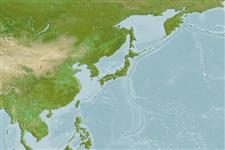Ikan bertulang rawan (sharks and rays) >
Squaliformes (Sleeper and dogfish sharks) >
Etmopteridae (Lantern sharks)
Etymology: Centroscyllium: Greek, kentron = sting + Greek, skylla = a kind of shark (Ref. 45335).
Environment: milieu / climate zone / depth range / distribution range
Ekologi
laut batidemersal; kisaran kedalaman 800 - 1000 m (Ref. 31244). Deep-water; 50°N - 38°N
Northwest Pacific: Emperor Seamount chain.
Size / Weight / umur
Maturity: Lm ? range ? - ? cm
Max length : 63.6 cm TL jantan/; (Ref. 31244)
Ovoviviparous (Ref. 205).
Life cycle and mating behavior
Maturities | Reproduksi, perkembang biakan | Spawnings | Egg(s) | Fecundities | Larva
Distinct pairing with embrace (Ref. 205).
Howe, J. and V.G. Springer, 1993. Catalog of type specimens of recent fishes in the National Museum of Natural History, Smithsonian Institution, 5: Sharks (Chondrichthyes: Selachii). Smithson. Contrib. Zool. 540:19. (Ref. 13292)
Status IUCN Red List (Ref. 130435)
ancaman kepada manusia
Harmless
penggunaan manusia
Alat, peralatan
laporan khas
muat turun XML
Sumber internet
Estimates based on models
Phylogenetic diversity index (Ref.
82804): PD
50 = 0.5078 [Uniqueness, from 0.5 = low to 2.0 = high].
Bayesian length-weight: a=0.00372 (0.00188 - 0.00734), b=3.10 (2.92 - 3.28), in cm total length, based on LWR estimates for this (Sub)family-body shape (Ref.
93245).
Trophic level (Ref.
69278): 3.8 ±0.3 se; based on size and trophs of closest relatives
Daya lenting (Ref.
120179): Rendah, Waktu penggandaan populasi minimum 4.5 - 14 tahun (Fec assumed to be <100).
Fishing Vulnerability (Ref.
59153): Moderate to high vulnerability (45 of 100).
